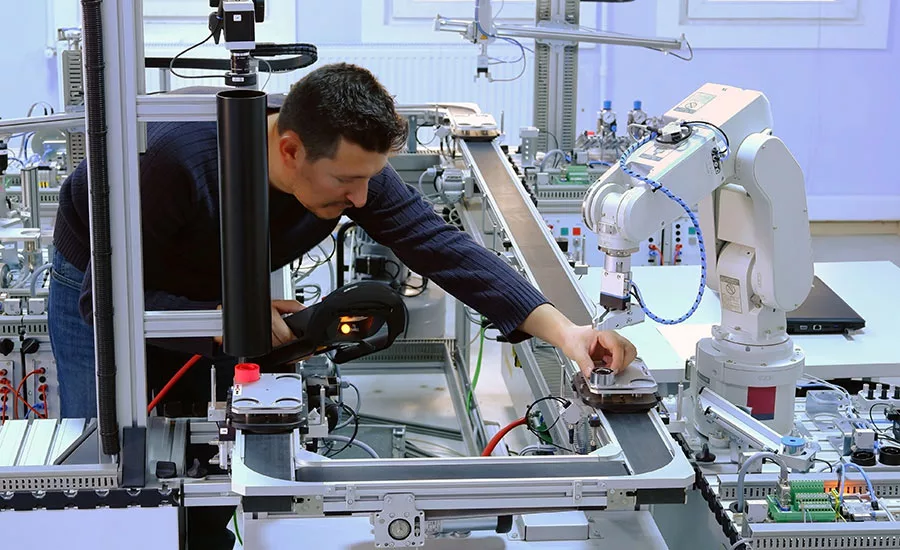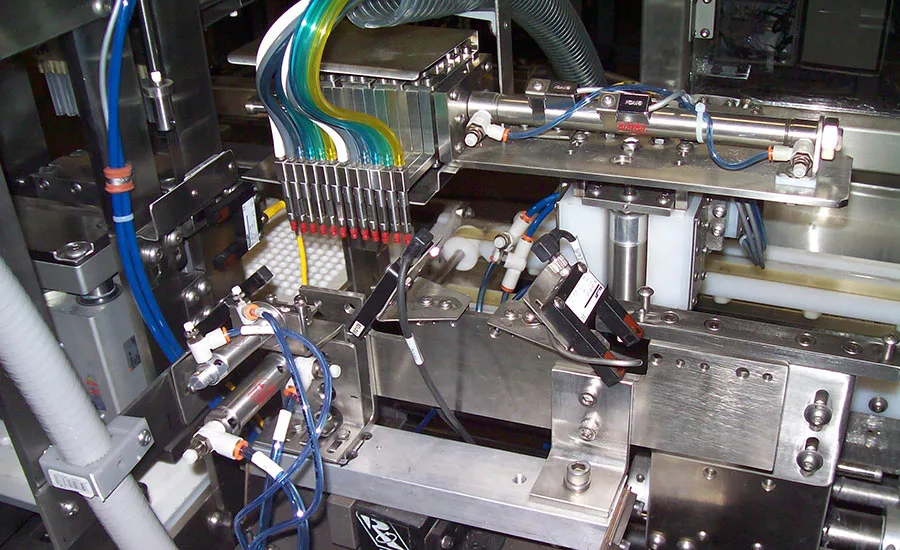System Integration
When automation projects need special attention and ASAP delivery, a one-stop SI delivers
Two uniquely different cases show how an adept system integrator can build customized equipment and lines not available off the shelf

For projects of any size, it can be crucial to partner with an expert system integrator/machine builder/supplier like Rapid Development Services to overcome obstacles such as meeting specifications, regulatory requirements, system integration and necessary customization as well as completing the work on time and within budget. All photos courtesy Rapid Development Services

Off-the-shelf equipment will not accommodate every application, particularly those that are complex with robots and conveyors, as well as a host of equipment for manufacture, assembly, packaging, labeling and palletizing, that must be flawlessly coordinated.

A distinct advantage can be gained when working with an integrator like Rapid Development Services, which can couple the knowledge of custom machine building with standardized robotics, as well as develop specific control and communication support between production machinery and operator inventory management systems.
Increasing production speed while keeping rejects low and quality consistent—and maintaining food safety—is the goal of every food and beverage processor. Today, many food processors look toward automation to provide the solutions needed to attain the necessary throughput to be competitive.
Problem is, while processors can buy off-the-shelf equipment to tackle a variety of automation applications, orchestrating all this equipment to tackle the job from start to finish can eat up a lot of engineering time. Even large food processors with in-house engineering departments will not always have the schedule to execute the integration of a line, especially those lines replete with robots and conveyors, as well as a host of equipment for manufacturing, packaging, labeling, palletizing, etc. that must be flawlessly coordinated. In many cases, automation suppliers won’t take on a complicated and large project without enlisting the help of system integrators and/or engineering house.
In this article two food processors—one with an existing facility and one with a new plant—needed production lines designed, built and completed as quickly as possible. Both called upon Rapid Development Services (RDS) to evaluate their projects and come up with an automated solution (including robotics). Both projects included novel inventions to accomplish their respective projects.
“While implementing off-the-shelf solutions can be a starting point for some food processing projects, automating and incorporating robotics frequently requires a custom solution that meets very specific process requirements. For this reason, even large suppliers in this space will often pass on opportunities if they are not easily resolved,” says Leon Gurevich, founder and chief technology officer of Rapid Development Services (RDS).
RDS is an industrial automation equipment builder, providing design, engineering, integration and fabrication of production machinery. The company has implemented over 300 complex, robotic, manufacturing and assembly projects worldwide, and has been awarded more than 40 patents.
“When it comes to automating food production, equipment can range from very small to complete lines several hundred feet long that can consist of robots, conveyors, vision systems, server drives, etc.,” says Gurevich, who has worked with companies such as General Mills, Cargill, Anheuser Busch, Johnson and Johnson, Abbott Labs, and Pfizer. “So, automation suppliers and integrators need a ‘tool box’ full of solutions including the ability to design and build from scratch in order to fit together all the pieces of the puzzle.”
RDS has designed and fabricated high-speed packaging machinery and robotic systems for products such as meat, baking goods, rice and other offerings for human or animal consumption. This has included primary packaging in form-fill-seal, pouch, bag, flow wrap, trays, carton, case and palletizing. Certain systems have included designs for wash downs as well as freezer to high-temperature environments.
Heavy-duty packaging lines for Riviana
For Riviana, the largest supplier of rice in the U.S., the automation equipment builder completed three large packaging projects for two plants. This involved packaging for bags of rice from 2-120 lbs., as well as packing for the rice bags.
Specifically, RDS designed, fabricated, and installed a packaging system to pack arrays of bags at up to 100 bags per minute into a container, and then place two of the containers onto a pallet. Another system loaded bags into a canvass sack with a strap used for shipping in cargo ships.
While this application may not sound that complex from this description, Gurevich’s company accepted the project. “The challenges for this first one-of-a-kind robotic system (no equipment or system existed to do the operation) were to solve the problem of achieving flexibility for one system to handle a wide range of bags and styles of the packaging at a very high rate of production,” says Gurevich. The bags were robotically packaged in Gaylord (heavy wall pallet size container) at a very high rate of up to 120 bags per minute, requiring a single pick-and-place transfer of the bags to be performed with multiple bags (up to 12 bags per pick).
Changeover time was critical and Gurevich reports, “The system exceeded customer’s requirements, to have a change over time of less than 15 minutes.” The design had universal tooling and programming, allowing seamless conversion from one size bag product to another without mechanical changes.
The application required new solutions in several areas, says Gurevich, which included:
- New technology was developed for staging and presentation of multiple bags for robotic pick up. The bags could be picked up and stacked side by side in the direction of its length or width.
- New technology was developed for a universal no-change end effector capable of reliably holding multiple size bags (8 sizes) from 2 lbs to 50 lbs per bag.
- New technology was developed for robotically erecting 48-in. tall full pallet size and half pallet size Gaylord.
Leave it to system integrators to come up with novel solutions. When asked how RDS designed the line to accommodate a range of product packaging, Gurevich responded, “The bag transfer system included servo-driven conveyors and first-of-a-kind RDS proprietary technology to allow bags’ accumulation on continuously moving belt conveyors.”
The technologies listed above have allowed loading of the bags into a Gaylord or to be placed into canvas sacks for shipment via ocean cargo ship. The system has the capability to load bags onto a pallet, as well as to be converted with a tool change for packing regular corrugated cases, says Gurevich.
Standard controls from RDS keep track of count, yield, up time and other data.
How did the project go? “The installation went very well from RDS. The crew was very organized and diligent in their execution of the installation and training,” says Rick Meyer, senior project engineer, Riviana.
Monsanto Dairy automation supplier didn’t deliver after one year
RDS typically uses standardized off-the-shelf solutions and integrates it with other systems, but can design and manufacture equipment and sub-systems for the food industry from scratch, as needed. This includes equipment such as inspection systems, packaging equipment, labeling/marking systems and palletizing automation, as well as filling systems and machine tending automation.
As an example, after trouble with an initial vendor, this approach helped Monsanto Dairy Group stay on schedule with the construction and start-up of a new facility in Augusta, Georgia, according to Chris R. Redford, P.E., principal pharmaceutical engineer, Monsanto AG Engineering, St. Louis, MO.
“The custom handling system [originally] purchased by the construction [firm] was found unacceptable after a full year of design and fabrication effort. This put us in a very difficult position. We either had to accept a poor-quality piece of equipment—and modify it to meet our requirements—or accept a lengthy schedule delay,” says Redford.
“The customer had ordered a custom servo-driven material handling system for sterile pharmaceutical grade food packaging from Europe,” says Gurevich. “The supplier was not able to meet delivery and performance goals, and [Monsanto] chose to acquire a robotic system from RDS. In spite of technical challenges, the fabrication and delivery was done in a record time.”
Redford credits RDS’s effort in getting the facility rollout back on track. “We were able to design a new handling system from scratch in just a few weeks,” says Redford. “[Rapid Development Services] designed the new system in modular sections that could be brought into the facility through standard door openings. This allowed us to continue facility construction with no delay.”
RDS developed new technology for robotic material handling for removing fine powder media out of the stainless trays into barrels—what turns out to be the first, one-of-a-kind system, says Gurevich.
The system required meeting Class 1 clean room specifications and featuring extremely high reliability (i.e., operating without a manual operator or technician to have access to a clean room for a minimum of 8 hrs). RDS developed a compressed air delivery and accumulation system built as a part of stainless gantry enclosure.
When asked how RDS managed to get a new system up and running in a few weeks when the prior company couldn’t get the job done in a year, Gurevich responded, “Over a period of nearly 30 years, Rapid Development Services has developed a process of robotic machine building when design and fabrication happens at the same time with close cooperation of all team members. RDS uses an extensive tool box of standard predesigned solutions, its standard controls and software packages, as well as a wide variety of specialty end effectors and robot bases: ‘out of the tool box’ to shorten machine building cycle.”
For more information, call (866) 900-1033; visit https://rapidds.com; email info@rapidds.com; or write to Rapid Development Services at 4329 Green Ash Drive, Earth City, MO 63045.
Looking for a reprint of this article?
From high-res PDFs to custom plaques, order your copy today!






